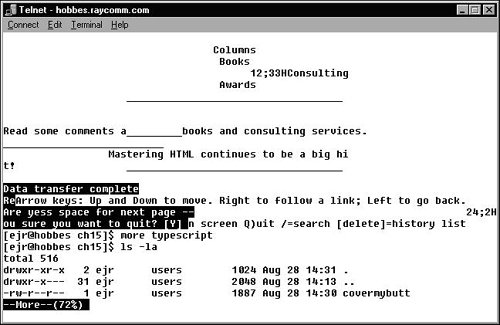Keeping a Record of Your Session with script Occasionally, you may need to keep a record of a Unix sessionfor example, if you're using Unix as part of a class assignment or need a session record to submit to your untrusting boss. You can do this using script, which keeps a record of every command you type from the shell prompt (Code Listing 15.7). You might think of typing script as pressing a Record button on a tape recorder. Code Listing 15.7. Using script is a great way to keep records. [ejr@hobbes ch15]$ more covermybutt Script started on Fri Aug 28 14:30:16 2005 [ejr@hobbes ch15]$ pwd /home/ejr/ch15 [ejr@hobbes ch15]$ who root tty1 Aug 28 14:18 ejr ttyp0 Aug 28 14:20  (calvin.raycomm.com) ejr ttyp1 Aug 28 14:28 (calvin.raycomm.com) ejr ttyp1 Aug 28 14:28  (calvin.raycomm.com) [ejr@hobbes ch15]$ ps ax PID TTY STAT TIME COMMAND 1 ? S 0:02 init [3] 2 ? SW 0:00 (kflushd) 3 ? SW 0:00 (kswapd) 48 ? S 0:00 /sbin/kerneld 229 ? S 0:00 syslogd 238 ? S 0:00 klogd 260 ? S 0:00 crond 272 ? S 0:00 inetd 283 ? S 0:00 lpd 298 ? S 0:00 sendmail: accepting connections on port 25 310 ? S 0:00 gpm -t ms 321 ? S 0:00 httpd 355 ? S 0:00 nmbd -D 368 1 S 0:00 /bin/loginroot 369 2 S 0:00 /sbin/mingetty tty2 370 3 S 0:00 /sbin/mingetty tty3 371 4 S 0:00 /sbin/mingetty tty4 372 5 S 0:00 /sbin/mingetty tty5 373 6 S 0:00 /sbin/mingetty tty6 375 ? S 0:00 update (bdflush) 381 1 S 0:00 -bash 402 ? S 0:00 in.telnetd 436 ? S 0:00 in.telnetd 249 ? S 0:00 /usr/sbin/atd 327 ? S 0:00 httpd 328 ? S 0:00 httpd 329 ? S 0:00 httpd 330 ? S 0:00 httpd 331 ? S 0:00 httpd 332 ? S 0:00 httpd 333 ? S 0:00 httpd 334 ? S 0:00 httpd 335 ? S 0:00 httpd 403 p0 S 0:00 /bin/login -h calvin (calvin.raycomm.com) [ejr@hobbes ch15]$ ps ax PID TTY STAT TIME COMMAND 1 ? S 0:02 init [3] 2 ? SW 0:00 (kflushd) 3 ? SW 0:00 (kswapd) 48 ? S 0:00 /sbin/kerneld 229 ? S 0:00 syslogd 238 ? S 0:00 klogd 260 ? S 0:00 crond 272 ? S 0:00 inetd 283 ? S 0:00 lpd 298 ? S 0:00 sendmail: accepting connections on port 25 310 ? S 0:00 gpm -t ms 321 ? S 0:00 httpd 355 ? S 0:00 nmbd -D 368 1 S 0:00 /bin/loginroot 369 2 S 0:00 /sbin/mingetty tty2 370 3 S 0:00 /sbin/mingetty tty3 371 4 S 0:00 /sbin/mingetty tty4 372 5 S 0:00 /sbin/mingetty tty5 373 6 S 0:00 /sbin/mingetty tty6 375 ? S 0:00 update (bdflush) 381 1 S 0:00 -bash 402 ? S 0:00 in.telnetd 436 ? S 0:00 in.telnetd 249 ? S 0:00 /usr/sbin/atd 327 ? S 0:00 httpd 328 ? S 0:00 httpd 329 ? S 0:00 httpd 330 ? S 0:00 httpd 331 ? S 0:00 httpd 332 ? S 0:00 httpd 333 ? S 0:00 httpd 334 ? S 0:00 httpd 335 ? S 0:00 httpd 403 p0 S 0:00 /bin/login -h calvin  raycomm.com -p 404 p0 S 0:00 -bash 437 p1 S 0:00 /bin/login -h calvin raycomm.com -p 404 p0 S 0:00 -bash 437 p1 S 0:00 /bin/login -h calvin  raycomm.com -p 438 p1 S 0:00 -bash 449 p1 S 0:00 ispell gudspeler 450 p0 S 0:00 script covermybutt 451 p0 S 0:00 script covermybutt 452 p3 S 0:00 bash -i 455 p3 R 0:00 ps ax [ejr@hobbes ch15]$ exit Script done on Fri Aug 28 14:30:44 2005 [ejr@hobbes ch15]$ raycomm.com -p 438 p1 S 0:00 -bash 449 p1 S 0:00 ispell gudspeler 450 p0 S 0:00 script covermybutt 451 p0 S 0:00 script covermybutt 452 p3 S 0:00 bash -i 455 p3 R 0:00 ps ax [ejr@hobbes ch15]$ exit Script done on Fri Aug 28 14:30:44 2005 [ejr@hobbes ch15]$
|
To Record Your Session with script: 1. | script covermybutt
At the shell prompt, type script to start recording your actions. You can save the transcript to a specified filename, as in script covermybutt. If you don't specify a file, Unix will save the transcript in the current directory as typescript.
| 2. | Do your thing. See you in a couple of hours.
| 3. | 
When you're done, press  to stop recording the session. to stop recording the session.
| 4. | more covermybutt
Use more or the editor of your choice to view the script. Code Listing 15.7 shows a sample transcript.
|
 Tips Tips
Screenbased programs, such as vi, pico, pine, mutt, or links, tend to wreak havoc with the output of script. You can still read the content, but the formatting is often badly out of whack, as shown in Figure 15.3. Figure 15.3. Some programs give you oddly formatted script output and strange beeps when you view the script.  You would use script if you want to record both what you did and what happened ("geez, I typed rm unbackedupdata, then ls, and sure enough, the ls listing showed that I was in big trouble"). On the other hand, if you just want the list of commands you typed with no indication of what happened, check out history from Chapter 3 ("geez, I typed rm unbackedupdata, then I typed ls, then I logged out and cried").
|
 (calvin.raycomm.com) ejr ttyp1 Aug 28 14:28
(calvin.raycomm.com) ejr ttyp1 Aug 28 14:28  Tips
Tips